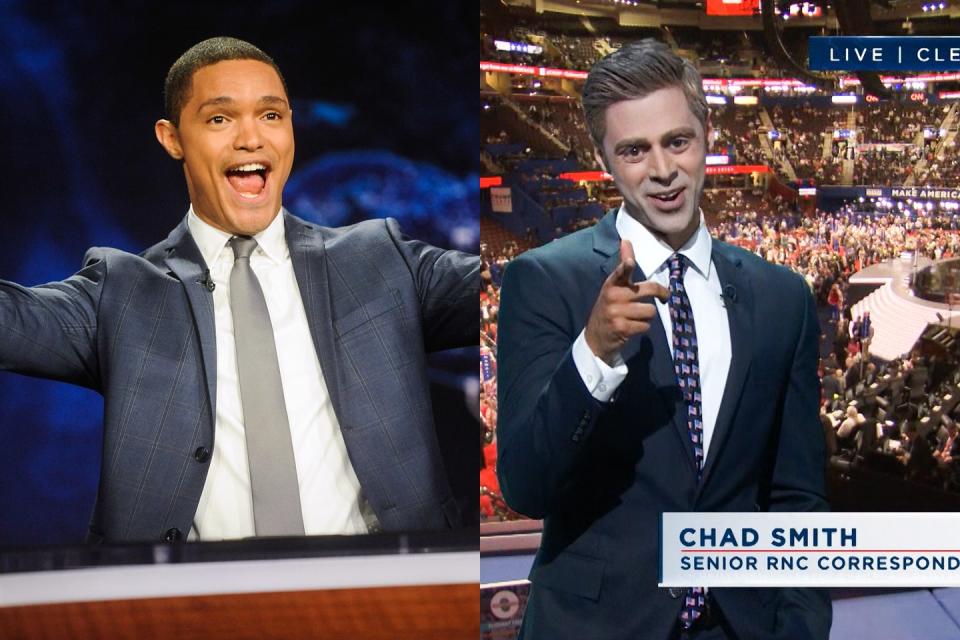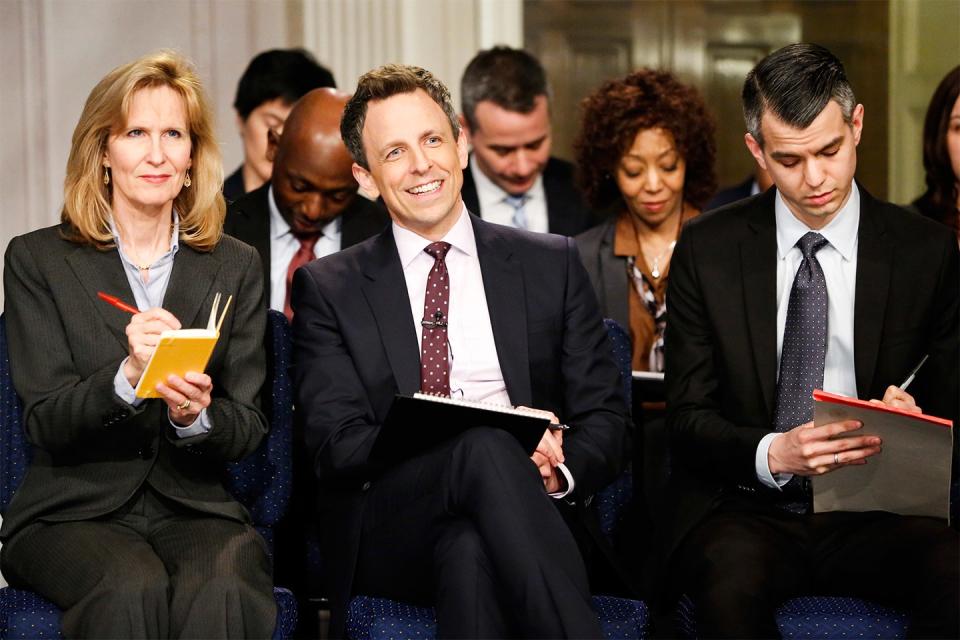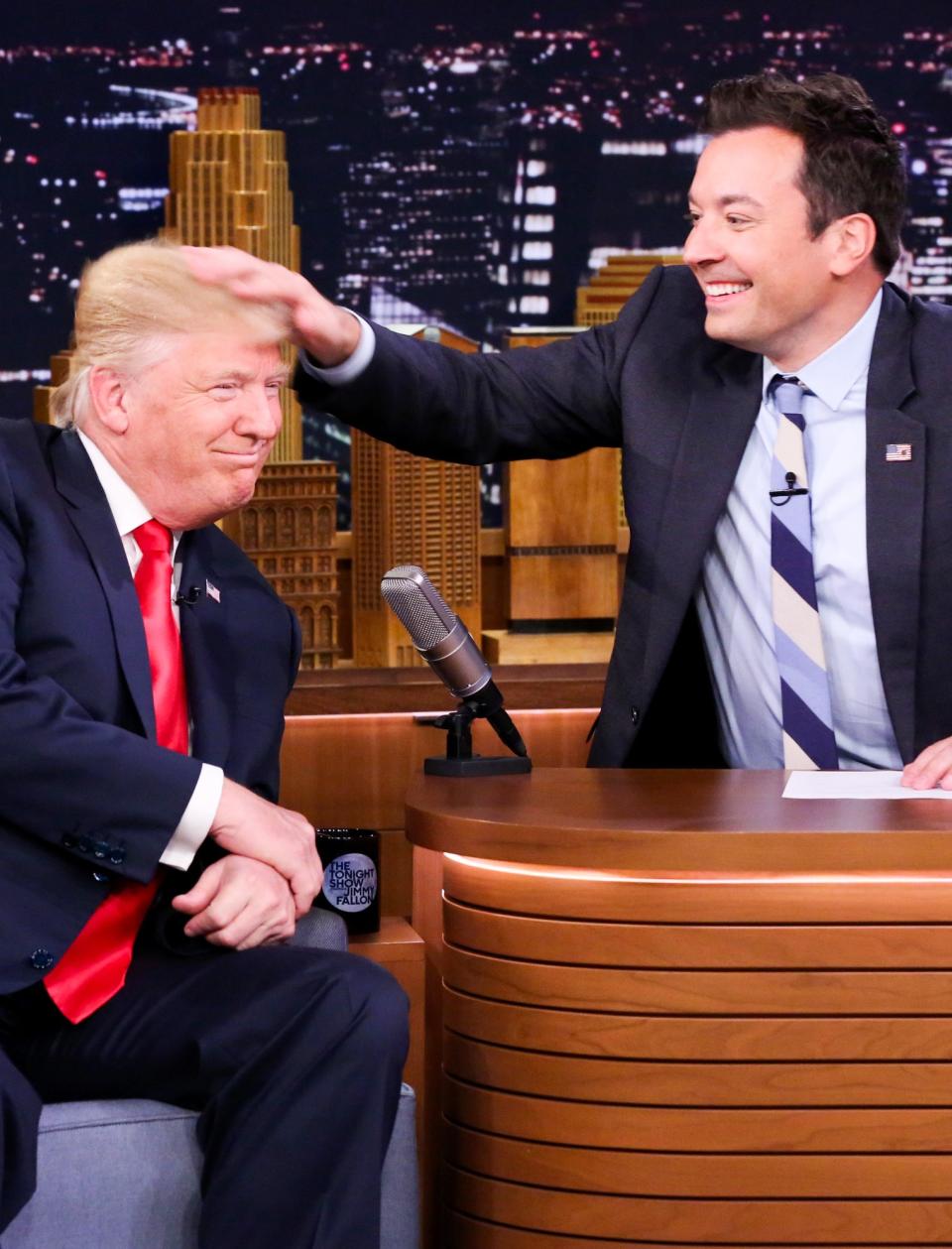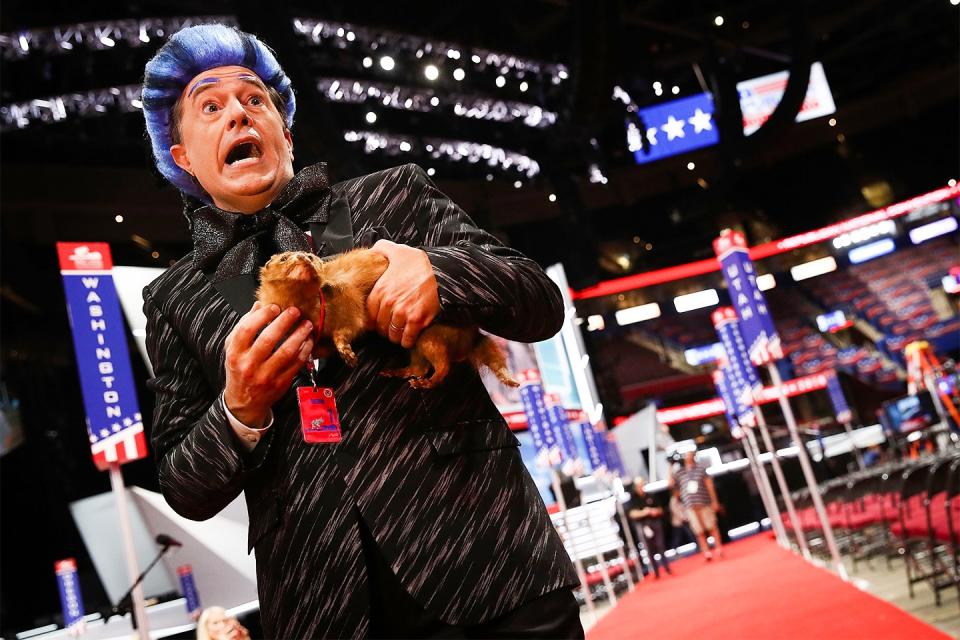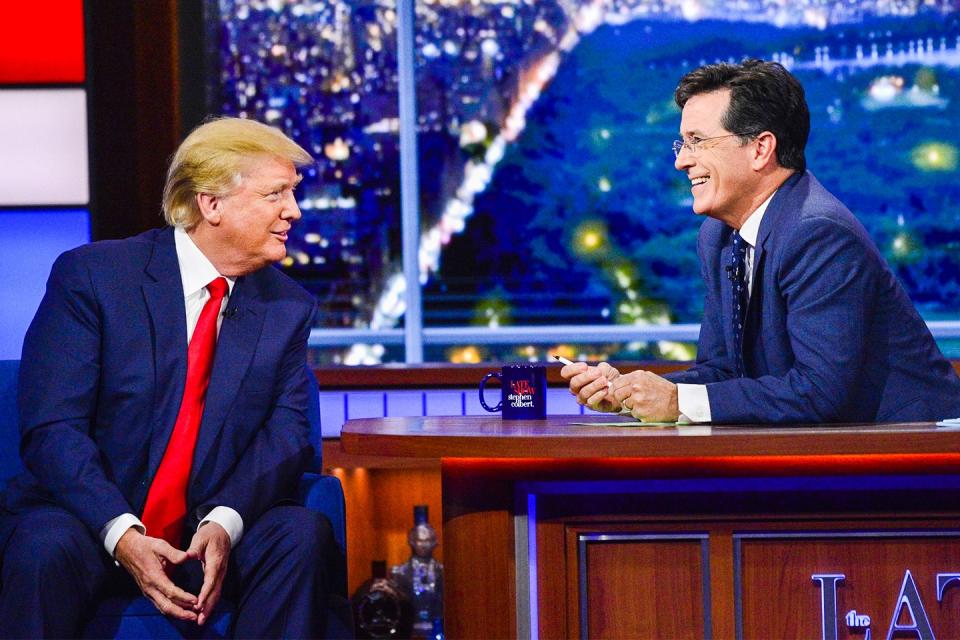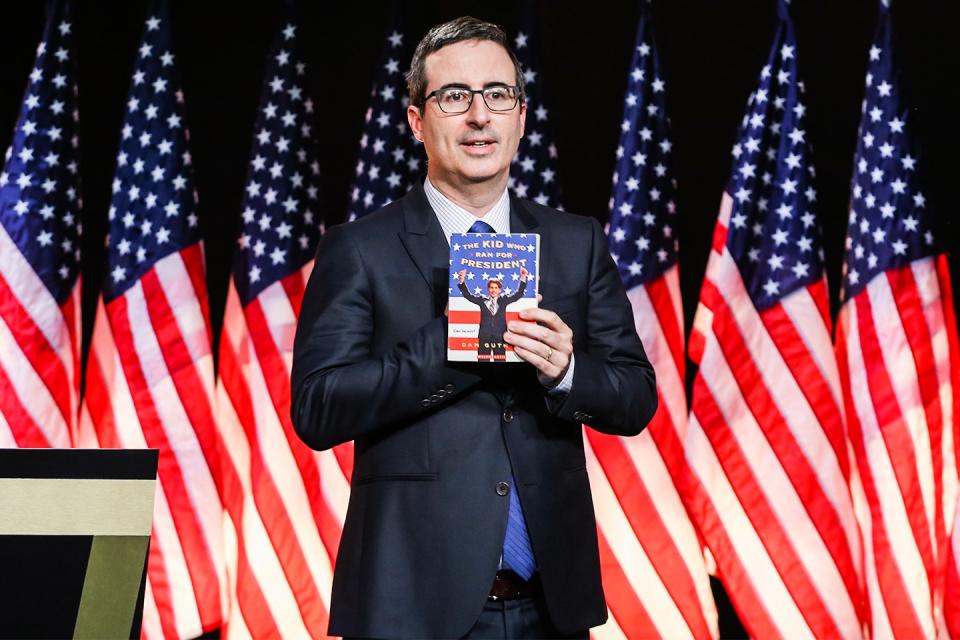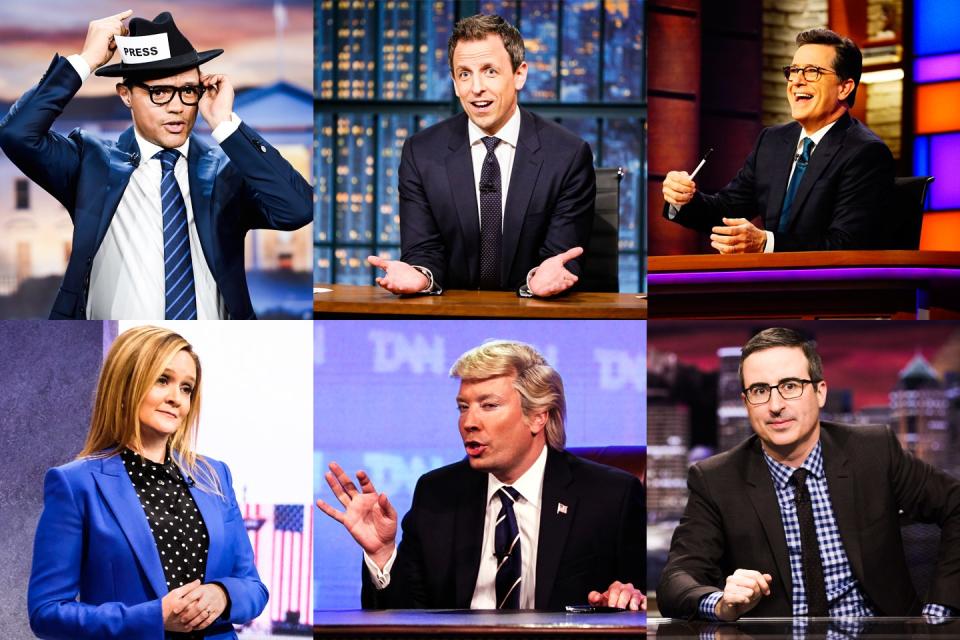How Late Night Sharpened Its Teeth in the Age of Trump
By Laura Bradley. Photos: Courtesy, Getty Images.
“Two minutes to air? Holy shit!”
“I can’t say shit once we start,” Stephen Colbert continued with a grin, mere moments before Late Show went live following Donald Trump’s speech to Congress on February 28. “Somebody remind me.”
Trump’s address had ended not even two hours before. But as I watched Colbert psych himself up before his live audience at the Ed Sullivan Theater last Tuesday, he didn’t look panicked. Instead, he looked ready—even eager. Only three months had passed since Colbert’s last live special on Election Day—which had quickly taken a turn many, including Colbert, did not expect. That night, Colbert managed to navigate uncharted waters with striking candor and composure. And on February 28, Colbert showed just how far he had come. As unpredictable as Trump’s remarks were, Colbert was ready for them: well practiced and prepared.
This marked Colbert’s fourth live broadcast in seven months. In the summer of 2016, he’d gained considerable momentum—if not significantly better ratings—by broadcasting without delay from both the R.N.C. in Cleveland and the D.N.C. in Philadelphia. His largely liberal audience tuned into Colbert’s subsequent live election special believing they’d watch him document the dawn of a Hillary Clinton presidency. Instead, they saw the birth of the Trump era—much to their, and his, growing horror.
But by the end of the night, the host managed to compose himself enough to deliver one of late night’s clearest responses to Trump’s victory. “Politics used to be something we thought about every four years—maybe two years, if you didn’t have a lot of social life,” he said. “It’s good that we didn’t think about [politics] that much, because it left room in our lives for other things, and for other people. . . . Now politics is everywhere. And that takes up precious brain space that we could be using to remember all the things we actually have in common.”
Last Tuesday, I was in the audience at the Ed Sullivan Theater as Colbert hosted his first live show since Election Night. In the intervening months, Colbert had ridden his now nightly fileting of Trump to a five-week run atop the ratings for his time slot—a once inconceivable feat made all the more remarkable for whom he was now consistently beating. As Colbert has risen, his genial NBC rival, Jimmy Fallon—who committed the cardinal sin of mussing Trump’s hair when he interviewed the then candidate in September—has fallen. That seesaw has signaled nothing short of a new era of late night.
In the age of Trump, nobody can ignore politics—least of all late-night hosts, who now face the task of helping their terrified viewerships process the harrowing stories about Trump’s administration that have a knack for breaking just as monologues are being set to cue card each night. Not so long ago, inoffensive viral hits were the coin of this realm. But where there are challenges, often, there is innovation—and right now, we’re seeing the dawn of a new late-night landscape. Nascent shows have quickly hit their stride amid the swirling political climate. Even the most established late-night institutions—like Fallon’s Tonight Show—are facing new realities as television, the medium that helped create Donald Trump, teaches citizens how to cope with him—and, yes, occasionally laugh.
By going live the night of Trump’s address in late February, Colbert was the only host able to rebut the president in something approximating real time—a full 24 hours before the rest of late night inevitably weighed in. Colbert seemed to grasp all this on Tuesday night in the minutes before air—and luckily, everything appeared to go off without a hitch.
“Technically, this was not a State of the Union,” Colbert said during his opening monologue, “because I think in this timeline, the Confederacy won.” From there, he pummeled Trump with barb after barb for 12 straight minutes.
“As we come to the end of tonight’s address to Congress, I think we can agree on one thing,” Colbert said. His next three words came with no shortage of acid: “One down, seven to go.”
Trump’s presidency has been like a news firehose, a challenge that’s vexing even the most seasoned White House reporters. But its rhythms have presented a unique equation for late night, where a 10 P.M. tweet might render an episode filmed in the early evening at least partially obsolete by the time it airs. The current, robust late-night lineup with seven hosts across five networks putting on nightly shows also means that writers rooms from 30 Rock to Fairfax have little choice but to cook with the same basic ingredients each night.
“There is not much else to talk about,” John Oliver said at a press breakfast at HBO’s New York offices in February as journalists sat around him, recorders, notebooks, and laptops at the ready as they munched on light breakfasts. “It’s rammed down people’s faces so constantly, and so aggressively, that I think it’s going to make [nightly shows] have cosmetic similarities in content. They’re going to get pushed into doing that thing, even if they don’t want to, because otherwise it seems like you’re not talking about the three things that people think of when they think of the day that just happened.”
Seth Meyers, whose Late Night with Seth Meyers celebrates its third anniversary this year, was willing to concede that there is one silver lining to Trump’s rise: “There used to be a feeling of dread as to what you were going to talk about every day,” Meyers said during a phone interview with Vanity Fair in February. “That is no longer a problem.”
On the other hand, as Daily Show producer Jen Flanz put it, “Being able to plan ahead has become virtually impossible.”
When Trump first announced his candidacy back in the summer of 2015, the late-night landscape looked very different. Jon Stewart was still hosting The Daily Show, as the series prepared for Trevor Noah to take the chair later in the fall. Colbert was off the air entirely, waiting to take over Late Show, which had just said good-bye to David Letterman. (Larry Wilmore’s Nightly Show was also still airing on Comedy Central, in Colbert’s old time slot.) Oliver was on his second season at HBO, and Samantha Bee’s Full Frontal had only been on air for a few months. Even Meyers was still relatively new to Late Night—and was still delivering his monologues standing up. Jimmy Fallon’s ratings looked impenetrably strong.
And for a while, things didn’t change. Despite Colbert’s efforts on CBS, ABC’s Jimmy Kimmel largely held his own in second place behind Fallon on NBC; Colbert, Noah, and Meyers didn’t ignore politics, but their politically charged segments didn’t feel instantly vital and viral. In making the move from Comedy Central to CBS, Colbert was committed to broadening his appeal beyond his old cable audience, which had thrilled to the faux–right wing pundit he played for years on The Colbert Report. But when Colbert interviewed Trump during his premiere week back in 2015, many viewers found the exchange, in which he apologized to Trump for past jabs, too gentle.
Ultimately, Colbert agreed with them. “I tried being gracious and pointed at the same time, and got almost nothing out of him,” he told The New York Times last September. “It was actually boring, because he wouldn’t even look me in the eye. Being nice to a guy who isn’t nice to other people, it doesn’t serve you that much.”
Since then, Colbert’s Late Show has been retooled—largely under producer Chris Licht, who co-created Morning Joe and came on board the Late Show in April as its first designated show-runner. (Up until that point, Colbert had been performing many of that position’s duties himself.) Once his plate was clearer, the ex–Comedy Central host hit a turning point after crashing the stage at the Republican National Convention in July, reviving the gleefully scathing tone his Colbert Report fans had been dying to see on his broadcast series.
That move has infused the Late Show with some much-needed energy—and allowed Colbert to finally overtake Fallon in the ratings. In February, Colbert beat Fallon in total weekly viewers for the first time since his Late Show’s premiere week. In the two weeks that followed, he widened the gap—though Tonight’s lead in the key 18–49 demographic remains virtually uninterrupted. And as Fallon’s sketches and Trump impressions have begun to boast a slightly edgier tone, he’s been able to narrow Colbert’s lead for two weeks in a row—proving that while the CBS host has a head start, this newly changed game is far from over.
More: The 20 Most Satisfying TV Kisses of All Time
Colbert’s sharper voice—and subsequent surge in popularity—should hardly surprise anyone; Colbert and Stewart were the ones who brought politics to the center of the late-night conversation during their Comedy Central heyday. As Meyers put it, both Jon Stewart’s The Daily Show and The Colbert Report changed the TV landscape in the mid-aughts by proving that “audiences did like hearing what a host’s point of view is.” And in a recent interview with Vulture, Letterman put an even sharper point on it, saying Stewart “made it so that not doing political stuff got to be the elephant in the room.”
As Colbert has found his voice on air at his new network, he’s become the leader of a sort of chorus that also includes hosts like Meyers, Noah, Oliver, and Bee—most of whom used to work for The Daily Show, and all of whom act as outlets for liberal outrage. Though it should be noted that what Colbert, Meyers, and Noah do is very different from Bee and Oliver’s gigs—the former host daily programs, whereas the latter two air shows just once per week. (Bee’s representatives told Vanity Fair that she was not available to be interviewed for this story.) For most young viewers, late night has never been “appointment TV”—but the interest Trump has generated in the field has sparked its closest digital-age facsimile, replete with viral videos and buoyed viewership.
Colbert and company have cracked the code. But what they offer is a stark contrast to what, just months ago, seemed to be a golden formula over on NBC.
Back in September, with the election just months away, Jimmy Fallon mussed Donald Trump’s hair. It didn’t play well.
As Twitter exploded, critics began to note the historic significance of what appeared to be a shift in expectations. Vulture’s Josef Adalian compared the exchange to when former Tonight Show host Jack Paar interviewed Fidel Castro—but also noted that Fallon hadn’t really done anything out of the ordinary, considering the normal tone of his iteration of Tonight. As the host himself put it to TMZ days later, “Have you seen my show? . . . I’m never too hard on anyone.” (Fallon and Tonight producers were not available to be interviewed for this story.)
The first presidential candidate to appear on a late-night show was John F. Kennedy, who sat down with Jack Paar in 1960. As TV reporting dean Bill Carter told Vanity Fair, Paar was “famous for being a real interviewer.” Even so, Kennedy’s answers were largely canned responses.
“The terms have changed [since then],” Carter said. “I mean, everything is much more adversarial now. Everything.”
Daily Show producer Steve Bodow agrees: “The emotional level of our audience, and just about everybody in the country, is really pitched,” he told Vanity Fair. “It has been for the last year, and it’s going to continue for awhile. . . . There’s a bit of dread, but also a lot of energy.”
Audiences, absorbing news all day on their social-media feeds, now expect their hosts to hold politicians and their colleagues accountable—or at minimum, as Carter put it, to ask “at least one or two meaty questions”—before moving on to the viral shenanigans.
That’s a simple enough task for series like the revamped Late Show or Seth Meyers’s Late Night, which orient themselves around a sharp, politically minded point of view. But it leaves gentler hosts like Fallon, James Corden, and Conan O’Brien in a more delicate position.
That tension flared when Fallon lobbed a few too many softballs Trump’s way during his interview in September. And as much as The Tonight Show has moved on, the interview’s legacy still seems to follow Fallon. Even when the comedian told pointed Trump jokes at the Golden Globes, some critics thought his barbs were “unearned”—too little, too late. But that doesn’t mean that hosts who avoid an apparent partisan bent can’t pull off a political interview: when Jimmy Kimmel interviewed Trump last May, he walked the finest of lines between grilling the Republican nominee and maintaining his show’s usual levity. He was largely successful on both fronts, proving Carter right in the assertion that after a couple “meaty” questions, there can still be room for the usual fun and games on shows like Jimmy Kimmel Live and Tonight.
Still, Fallon may have to lampoon Trump with as much vigor as his cohort if he hopes to keep up—and lately, as his Trump impressions get ever so slightly edgier, it seems he’s more than game to take a whack at it. (One has to wonder if this approach is at least in part what’s helping Fallon close the ratings gap with Colbert in the past couple weeks.) But for every late-night host, the key is differentiation: What angle could possibly allow a show to stand out from the crowd?
Perhaps the most astounding thing about late night during Trump’s first month in office is how hosts found ways to riff on the same topics, night after night—largely without repeating one another.
Obviously, that’s by design. Meyers compared the business of late night to the news industry: “A bunch of newspapers still exist,” he explained. “I think, more than ever, that’s a reminder to those of us who do shows like this to make sure you keep it in your voice. Because there are other unique voices talking about the same thing.”
For Meyers and other point-of-view-driven hosts like Colbert and Noah, that voice isn’t just a style of humor—it’s also a distinct expression of outrage. Meyers tends to be more satirical, while Colbert has bemusement down to an art form. Noah tends to punch up his humor with outbursts—either of laughter, or yelling for comedic effect. Either way, that distinct alchemy of humor and fury has become each host’s calling card—and audiences are forming factions around them.
Right now, Colbert is leading the point-of-view pack. But Trevor Noah, who had the gargantuan task of taking over The Daily Show from Jon Stewart, has also found stronger footing in the age of Trump. Producer Steve Bodow said he noticed a shift around the time of last summer’s political conventions: “I think he started to feel much more organically in tune with where the audience was at, and vice versa.”
A buzzy interview with conservative firebrand Tomi Lahren in November brought a resurgence of attention, and Noah is also carving out a niche of his own by offering a global perspective on current events. (As Comedy Central has pointed out, he also continues to win among millennial men, and places second only to Fallon among millennials more broadly.) Now that Trump is in office, the diverse perspectives offered by Noah’s correspondents could become even more vital: take, for example, Hasan Minhaj, whose impassioned and witty responses to Trump’s Islamophobia still stand as late night’s most important treatments of this issue.
Meyers, too, had an epiphany—when he started sitting down for his monologues, instead of standing up, which is usually de rigueur for a late-night host. Suddenly, the Late Night host seemed at home. And in recent months, especially, Meyers has honed a distinct perspective: snarky, satirical, and occasionally silly.
Meyers has admitted before on air that he never expected Trump to win—so, as he told Vanity Fair, shortly after the businessman announced his candidacy, the show decided to “make hay while the sun’s shining.”
But spending all that energy on Trump—fleeting as though they believed his run would be—“built this infrastructure at the show that we kind of learned how to move quickly and talk about all the material he was providing on a daily basis,” Meyers continued. “For us, it was the election in itself that I think helped change us into the show that we’ve become.”
Even Kimmel, who presents a more traditional, personality-driven show, has been doing some of his best work in recent months, as Carter noted. The comic has found his own impish way to take on the president—including a recurring feature in which videos of the president speaking are slowed down and dubbed “Drunk Donald Trump.”
That leaves Corden and Fallon, both of whom are more like the classic late-night hosts—who rarely revealed much of a partisan bias. (Letterman recalled in his New York interview that Johnny Carson had an “unstated policy” not to mention the Vietnam War on air, because “with the six o’clock news, the last thing people wanted to hear more of was young Americans dying painfully.”) Although both Corden and Fallon followed that template for some time, it seems they’ve each inched just a little closer to the edge. Take, for example, Corden’s best post-Oscars joke: “They were sent out there with the wrong information, and were expected to make it work. Basically, they were the Sean Spicer of the Oscars.”
In this regard, Fallon’s soundalike Trump impression could be his secret weapon—a goofy voice that makes even sharper barbs palatable for politically diverse audiences. While tackling Trump’s address to Congress, Fallon managed to mock both Trump and the media’s breathless response to his seemingly subdued tone with just one in-character line as Trump: “Everyone’s saying I was so presidential. Because I started. Talking. Like this. In a slow. Deeper. Voice. Wasn’t I presidential? Wasn’t I presidential?!”
Sure, everyone wants a good Trump rant now—but won’t audiences crave some sort of counter-programming after, say, two years of this?
“This is all still very new,” Seth Meyers noted, “and we’re aware that one day we could come out, and the audience could sort of reach an exhaustion point of, ‘No thank you. Talk about anything but this.’ So, we haven’t hit a point of exhaustion, but you do have a responsibility, I think, to the audience . . . to present a show you’re proud of, while keeping in mind that audiences don’t always want the same thing year after year.”
If the demand for outrage dies down, Fallon could find himself in a sweet spot once more—prepared to give the country some gentler Trump fare. But, realistically, it can be very hard for late-night shows to project and plan based on what audiences might expect in the future. Multiple hosts and producers told Vanity Fair that they don’t necessarily focus on audience expectations, or design formal strategies for their shows based on hypothetical audience desires. As Meyers put it, “One of the nicest things about doing these shows is we don’t have a lot of time for things like strategy meetings, or future planning. We kind of have to pick it up as we go.”
Still, as Meyers added, listening to the audience is important. In that vein, it appears Fallon and his team have already begun fine-tuning their approach: for instance, his recent Trump impressions and sketch material like his Betsy DeVos segments have become a little more pointed—in a subtle way that both satisfies modern demands and preserves Tonight’s traditionally gentle, nonpartisan bent.
It’s almost certain that the balance will shift once more, elevating shows with a different alchemy. When that happens, there’s no telling who might come out on top—but these are not the late-night wars of yesteryear. Across every show, there seems to be an attitude that there’s plenty of room for everyone: the more comedians mocking Trump, the merrier. Because the other option—viewers becoming overwhelmed with the state of current events and tuning out—is just too harrowing to allow.
This story originally appeared on Vanity Fair.
More from Vanity Fair:
The People v. OJ Simpson Cast and Their Real-Life Counterparts
Pics of Royals Skiing Through the Years
